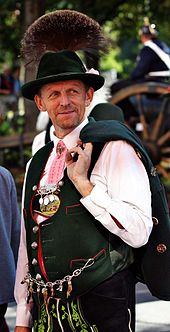Bavarian costume
As a Bavarian costume which is first of all well- Upper Bavarian mountain costume understood with the lederhosen for men and dirndl Gwand for Women (the dirndl or Dirnei, hence the name). This mountain costume became at home in regions outside the mountains through traditional costume clubs and through labor migration. Today one can distinguish six types of mountain costumes:
- Miesbacher costume ,
- Werdenfels costume ,
- Inntaler costume ,
- Chiemgau costume ,
- Berchtesgaden traditional costume ,
- Isarwinkler costume .
However, the mountain costume is not in the narrower sense the "Bavarian costume", which does not even exist as such. Rather, there are countless variants of the traditional costume , which differ not only in the regions of Old Bavaria , Franconia and Swabia . In the course of time and fashions, a wide variety of traditional costumes have also developed locally.
In the last few decades, not only the Upper Bavarian mountain costumes have been cultivated in many areas of Bavaria , but also attempts have been made to keep local costumes and peculiarities alive ( old costumes ) or to revive them ( renewed costumes ) or to recall historical traditions ( historical costumes ). One of the most valuable and well-known local costumes is the Dachau costume , which, in terms of traditional costumes , has never been able to radiate as widely. A description of the Dachau costume can be found on the website of the "D'Ampertaler" costume association.
For research and advice on the mostly voluntary initiatives, z. B. the costume research and advice center of the district of Middle Franconia was set up in Schwabach in 1986 or the costume information center of the district of Upper Bavaria in Benediktbeuern.
Not to be forgotten is the maintenance of traditional costumes for the displaced .
history
Originally, traditional costumes were generally understood to mean "wearing" clothing or the "worn" clothing itself. The rural costume, like urban clothing, was subject to changes in fashion. The history of traditional costume in Bavaria cannot be separated from the traditional costume movement. At the beginning of the 19th century there was a real enthusiasm for traditional costumes at the Bavarian court, but also in Vienna . By Joseph Hazzi from Abensberg the first detailed description of the native costumes of the various dishes. In 1830, the archivist of the Bavarian Estates Assembly, Lipowsky , brought out a "Collection of Bavarian National Costumes". In honor of the silver wedding anniversary of King Ludwig I of Bavaria and Queen Therese , a costume parade took place for the first time in 1835. Under his successor Max II , the costume became acceptable. The king officially included traditional costume wearers in his court ceremony, himself wore traditional jackets with lederhosen when hunting and wrote in 1849 that he saw the preservation of national costumes as "of great importance" for national feeling, since then the costume was acceptable in Munich. State authorities tried again and again to preserve the national costumes. So on June 1, 1853 with the letter of the presidium of the royal government of Upper Bavaria to "raise the national feeling, especially the national costumes". On April 4, 1859, the "Gemüthlichkeit" society was registered in Miesbach , the forerunner of the Miesbach traditional costume association founded in 1884. Around 1883 the teacher Josef Vogl in Bayrischzell also campaigned for the preservation of the old costumes and local customs. On August 25, 1883, together with other young boys, he founded the first "Mountain Costume Conservation Association". In 1890, at the suggestion of Thomas Bacher in Bad Feilnbach, Gauverband I was founded as the first umbrella organization for traditional costume clubs.
One of the most prominent folk keepers was Prince Regent Luitpold of Bavaria , the successor to Ludwig II. Like the Austrian Emperor Franz Joseph I, he was often seen in short lederhosen (in cold weather with long white underpants!) When hunting.
The regional association of Bavarian traditional and national costume associations was founded as early as 1909.
Even after the First World War , the traditional costume clubs were still alive. On October 25, 1925, the "United Trachtenverbände des Bavarian Oberlandes" (today: Bayerischer Trachtenverband eV) was founded in the Hackerkeller in Munich . It comprised 10 founding district associations together with 303 associations and 19,135 members.
Shortly after the re-approval of the traditional costume clubs in 1948, there were 500 traditional costume clubs with around 45,000 members.
In 2002, the two Bavarian state costume associations merged through a merger agreement. There are now 23 district associations in the newly founded Bavarian costume association with around 180,000 members.
See also
literature
- Uli Landsherr: Trachtler schee boarisch . Husumer Verlagsgesellschaft, Husum 2008, ISBN 978-3-89876-413-1 .
- Paul Ernst Rattelmüller : Bavarian costumes . Riedler publishing house, Rosenheim 1955.
- United Bavarian Costume Associations (Ed.): Bayrisch Land, Bavarian Gwand, historical contribution to traditional costume and homeland maintenance in Bavaria, on the occasion of the 50th anniversary of the United Bavarian Costume Associations . Chiemgauer Verlagshaus - self-published United Bavarian Costume Associations, Traunstein 1976, OCLC 140201858 .
- Simone Egger: The Oktoberfest costume phenomenon. Identity Practices in an Urban Society. Dirndl and Lederhosen, Munich and the Oktoberfest. Utz, Munich 2008, ISBN 978-3-8316-0831-7 (= Munich ethnographic writings , volume 2).
Web links
- Bavarian Trachtenverband eV
- Costumes research and advice center for the Middle Franconia district
- Trachten-Informationszentrum (TIZ) Upper Bavaria
- Information center for traditional costumes and folk culture in Upper Franconia
- Trachtenkulturberatung District Swabia
- More about traditional costumes in Swabia
- History of traditional costume and the traditional costume movement in Bavaria
- “Tracht phenomenon”. Special edition EDITION BAYERN (House of Bavarian History)
- The traditional knife
Individual evidence
- ↑ Customs and costumes . D´AMPERTALER DACHAU e. V. Accessed April 5, 2019.



